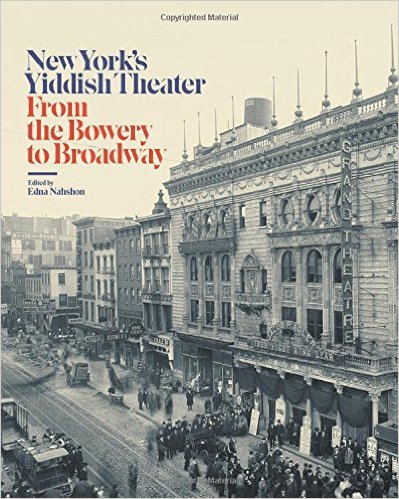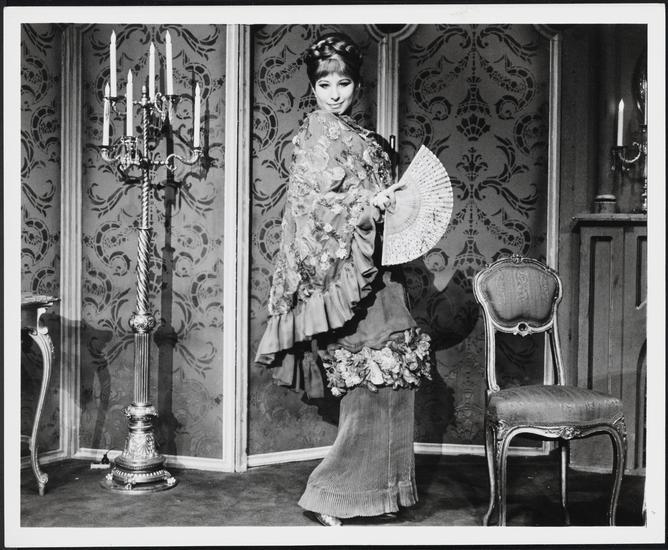Richard C. Norton
Operetta Research Center
13 October, 2016
As a companion volume to its recent exhibition on New York’s Yiddish Theater: From the Bowery to Broadway, the Museum of the City of New York (and Columbia University Press) have published a handsome 326-page volume of twelve essays, edited by Edna Nahshon. The volume is prodigiously illustrated with hundreds of images from the Collections of the Museum of the City of New York and the YIVO Institute for Jewish Research. Sadly the exhibit has now ended, but this book is the next best thing.

Grand Theater advertising Jacob P. Adler in “The Jewish King Lear,” c. 1905. (Photo: Byron Company/Museum of the City of New York, J. Clarence Davies Collection)
The director’s foreward by Susan Henshaw Jones opens the book thus: “From the late 19th to the mid-20th century, a thriving Yiddish theater culture blossomed on Manhattan’s Lower East Side. Second Avenue became a “Yiddish Broadway,” where over 1.5 million first- and second-generation Eastern European Jewish immigrants came to celebrate their culture and to learn about urban life in the city. They did so via cutting-edge dramas, operettas, comedies, musical comedies and avant-garde political and art theater.” To that I might add Yiddish variety, vaudeville and cabaret.

Molly Picon in the Yiddish film “The Jolly Orphan,” 1929. From “New York’s Yiddish Theater: From the Bowery to Broadway.”
Operetta Research Center readers may rightly ask how much musical theatre content is contained therein, and is it worth buying? Yes! Edna Nahshon’s Chapter 1 (“Overture: From Broadway to the Bowery”) offers a historical survey of the theatres, personalities and historical trends which shaped Yiddish theatre. Hasia Diner’s Act 1 (14 pages) offers a succinct précis on the forces of immigration which contributed to the demand for theatrical entertainment. Nahmha Sandrow’s Act 2 “Popular Yiddish Theater: Music, Melodrama and Operetta” (20 pages) speaks at length about operetta composers Louis Friedsell, Herman Wohl, Sholom Secunda and Joseph Rumshinsky, and its many performers, Ludwig Satz, Molly Picon, etc. A reconstructed staging of The Golden Bride (Di goldene kale), a hit from 1923, featured on pp. 80-2, just enjoyed two extended runs this past summer at the Folksbienne Thatre in lower Manhattan, and now plans a national tour.

Cover for the catalogue “New York’s Yiddish Theater: From the Bowery to Broadway.”
Acts 3-4-5 cover Jacob Gordin (billed as the great reformer), Jacob P Adler, Boris Thomashefsky and Molly Picon (pathbreakers and superstars), and Maurice Schwartz (Yiddish Art Theater Movement). Where would Yiddish Theater be without politics? (Act 6) Arnold Aronson’s Act 7 adresses the subject of scenic and costume design, with Boris Aronson’s amazing journey from pre-revolutionary Russia to the Bronx to Broadway, as a vibrant example of the enduring impact of Yiddish artists on mainstream culture. Act 8 concerns Yiddish Puppet Theater, wherein music and song were an indelible part. Edna Nahshhon and Judith Thissen offer companion essays in Act 9, on Yiddish Vaudeville. As Jewish audiences prospered and dispersed, Nahshon’s Act 10 addresses the mid-century phenomenon of Borscht Belt Entertainment in the Catskills, wherein Jerry Lewis, Red Buttons, Danny Kaye, Sid Caesar, Phil Silvers, Mickey Katz and Jackie Mason among other got their start. Add to that writers like Neil Simon, Sheldon Harnick, Michael Stewart, Larry Gelbart, etc. Alison’s Solomon’s closing Act 11 addresses the inevitable assimilation into mainsteam American culture with Tevye’s Travels: From Yiddish Everyman to American Icon. The closing pages offer a gallery of 20 biographies of major players.

Barbra Streisand as Fanny Brice in “Funny Girl,” 1968. (Photo: Museum of the City of New York, Gift of Frank Goodman)
This indispensable book is a fun read, easy to browse through, get lost in. It is no dry academic treatise, but a generous yet scholarly account of a now-vanished era of popular Yiddish culture. Highly recommended, even if you don’t read or speak Yiddish!
